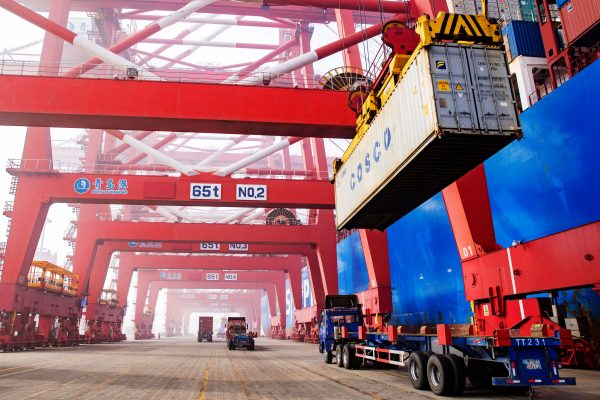In July 2018 the United States imposed a 25 per cent punitive tariff on US$50 billion worth of Chinese imports, most of them high-tech goods. China adopted a tit-for-tat policy, resulting in the United States imposing an additional 25 per cent tariff on US$200 billion worth of Chinese goods. The following year, after consultations and negotiations, both parties finally reached the phase one trade agreement on 15 January 2020.
Under that agreement, China promised to import an additional US$200 billion worth of energy and agricultural products and services from the United States in the following two years.
Along with punitive tariffs came technology sanctions. The United States launched a technology war against China, imposing sanctions on Chinese firms ZTE and Huawei in 2018 and 2019 respectively.
Both countries suffered from the trade and technology conflict. Since China’s reform and opening-up, it has become deeply integrated into the world economic system and has grown into a global processing and manufacturing hub. It imports intermediate goods and raw materials from Asian economies and other mineral goods from other resource-exporting countries, and runs a huge trade deficit with these economies in goods. After processing and manufacturing these imported intermediate goods and raw materials, China exports these goods to other countries, particularly to European, American and Japanese markets. China runs a large trade surplus in goods with these countries.
The United States holds key positions along global value chains (GVCs). It controls the core technology of high-tech GVCs, but also the marketing outlets of other important GVCs through brand and sales networks. American consumers enjoy low-cost and high-quality imports and US multinational companies earn high operating profits, all while the United States maintains a huge trade deficit with many of its trading partners.
Taking the 2019 trade balance of goods among its top 100 trading partners as an example, China ran a trade surplus with 60 out of its top 100 trade partners, while the United States ran a deficit with 61 out of 100. China’s top 100 trading partners accounted for 95.6 per cent of Chinese total trade value in 2019, while the United States’ top 100 trade partners accounted for 99.4 per cent of US total trade value.
The United States’ trade war with China has severely inhibited trade in goods between the two countries. Goods that are efficiently made in China must now be manufactured in neighbouring countries, increasing production costs and lifting product prices. This hurts American consumers who then have to pay more for the same imported goods, and American multinational companies which suffer from reduced profits.
The trade war also directly reduces the scale of US–China bilateral trade. In 2018, China was the United States’ largest bilateral trade partner, with two-way trade valued at US$659.8 billion — greater than the United States’ trade with Canada, Mexico and the European Union (excluding the United Kingdom). With the trade war under way, in 2019 the value of Chinese goods trade with the United States fell by US$101 billion and China fell to 4th place in trade with the United States.
An international system based on multilateralism and rules is a valuable but fragile global public good. Unilateralism among great powers, especially countries with potential hegemonic power, will not only cause both sides to lose, but also undermine the rules-based international order and lead to the collapse of multilateralism. Unilateralism by any one great power will trigger retaliation from others. The threat of bilateral retaliation and sanctions will continue to escalate under these conditions.
China finds itself in a dilemma over its increasing trade and technology tensions with the United States: if it does not respond and instead chooses to wait for intervention from the World Trade Organization (WTO), it will have to wait for a long time for any real action. It took two years for the WTO to rule that the Section 301 tariff imposed by the United States on China was illegal. It would take even longer to rectify US wrongdoing.
During this process, China would suffer losses inflicted by the United States. This effect would only intensify over time. If China undertakes tit-for-tat measures, it will gradually deviate from multilateralism and move towards bilateralism. This is the mechanism of adverse selection in the international order. Under this mechanism, the rules-based order can easily be destroyed by great-power competition.
Bilateralism would also lead to US–China economic decoupling, forcing a slide into inward-looking development, and their establishing independent and local supply chain systems. Little by little, this would produce two parallel and opposing international economic systems, resulting in large costs from the investment and trade diversion effects (albeit in exchange for the independence and security of each country’s production and supply).
The trade and technology war between China and the United States is unfortunately moving in this direction. Even if the United States had launched the 301 action earlier, or China had chosen to respond and retaliate later, the final result would have been the same. Both countries will slide from multilateralism to bilateralism, and from a rules-based system to a power-based system.
The world’s great powers should bear in mind their international responsibilities. Great powers should try to avoid unilateralism, and instead use dialogue and cooperation to deal with bilateral problems.
Song Hong is Professor, Senior Fellow and Deputy Director-General at the Institute of American Studies, Chinese Academy of Social Sciences (CASS).
This article appears in the most recent edition of East Asia Forum Quarterly, ‘How China is changing’, Vol. 12 No. 4.

